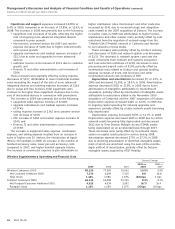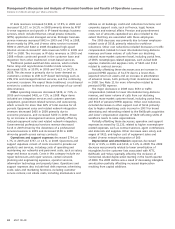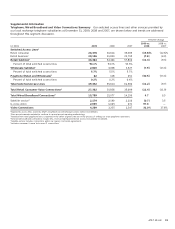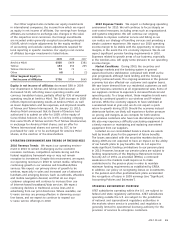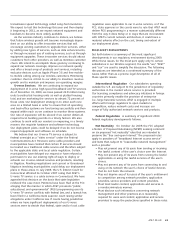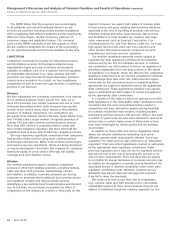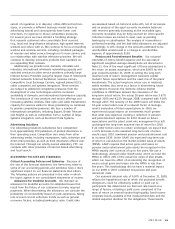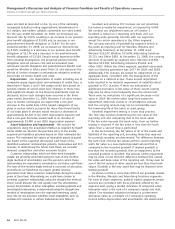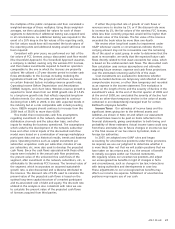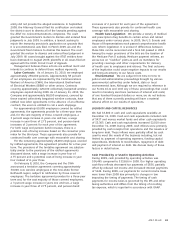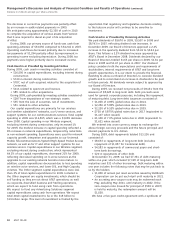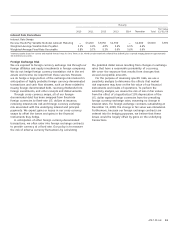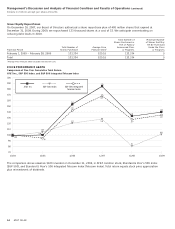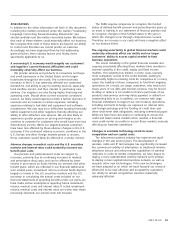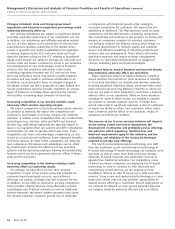AT&T Wireless 2009 Annual Report Download - page 48
Download and view the complete annual report
Please find page 48 of the 2009 AT&T Wireless annual report below. You can navigate through the pages in the report by either clicking on the pages listed below, or by using the keyword search tool below to find specific information within the annual report.
Management’s Discussion and Analysis of Financial Condition and Results of Operations (continued)
Dollars in millions except per share amounts
46 AT&T 09 AR
Goodwill and wireless FCC licenses are not amortized
but tested annually for impairment, as required by GAAP.
We conduct our impairment tests as of October 1.
Goodwill is tested on a reporting unit basis, and our
reporting units generally coincide with our segments,
except for certain operations in the Other segment.
The carrying amounts of goodwill, by segment (which is
the same as reporting unit for Wireless, Wireline and
Advertising Solutions), at December 31, 2009 were:
Wireless $35,037; Wireline $31,608; Advertising Solutions
$5,731; and Other $883. At December 31, 2008, the carrying
amounts of goodwill by segment were: Wireless $33,851;
Wireline $31,381; Advertising Solutions $5,694; and
Other $903. Within the Other segment, goodwill associated
with our Sterling operations was $477 for 2009 and 2008.
Additionally, FCC licenses are tested for impairment on an
aggregate basis, consistent with the management of the
business on a national scope. These annual impairment
tests resulted in no material impairment of indefinite-lived
goodwill or FCC licenses. If there are indications of
significant decreases in fair value of these assets, testing
may also be done more frequently than the annual test.
There were no indications of a significant decrease in fair
value in 2009. We review other long-lived assets for
impairment whenever events or circum stances indicate
that the carrying amount may not be recoverable over
the remaining life of the asset or asset group.
Goodwill impairment testing is a two step process.
The first step involves determining the fair value of the
reporting unit and comparing that to the book value.
If the fair value exceeds the book value, then no further
testing is required. If the fair value is less than the book
value, then a second step is performed.
In the second step, the fair values of all of the assets and
liabilities of the reporting unit, including those that may not
be currently recorded, are determined. The difference between
the sum of all of those fair values and the overall reporting
unit’s fair value is a new implied goodwill amount that is
compared to the recorded goodwill. If implied goodwill is
less than the recorded goodwill, then an impairment to the
recorded goodwill is recorded. The amount of this impairment
may be more or less than the difference between the overall
fair value and book value of the reporting unit. It may even be
zero if the fair values of other assets are less than their book
values. Goodwill is the only asset that may be impaired when
testing goodwill.
As shown in Note 6, more than 98% of our goodwill resides
in the Wireline, Wireless and Advertising Solutions segments.
For each of those segments, publicly traded companies whose
services are consistent with those primarily offered by the
segment exist, giving a market indication of enterprise value.
Enterprise value is the sum of a company’s equity and debt
values. One standard valuation technique is to determine
enterprise value as a multiple of a company’s operating
income before depreciation and amortization. We determined
were all rated at least Aa3 or AA- by one of the nationally
recognized statistical rating organizations, denominated in
U.S. dollars, and neither callable, convertible nor index linked.
For the year ended December 31, 2009, we decreased our
discount rate by 0.50%, resulting in an increase in our pension
plan benefit obligation of $2,065 and an increase in our
postretirement benefit obligation of $1,847. For the year
ended December 31, 2008, we increased our discount rate
by 0.50%, resulting in a decrease in our pension plan benefit
obligation of $2,176 and a decrease in our postretirement
benefit obligation of $2,154. Should actual experience differ
from actuarial assumptions, the projected pension benefit
obligation and net pension cost and accumulated post-
retirement benefit obligation and postretirement benefit cost
would be affected in future years. Note 11 also discusses the
effects of certain changes in assumptions related to medical
trend rates on retiree health care costs.
Depreciation Our depreciation of assets, including use of
composite group depreciation and estimates of useful lives, is
described in Notes 1 and 5. We assign useful lives based on
periodic studies of actual asset lives. Changes in those lives
with significant impact on the financial statements must be
disclosed, but no such changes have occurred in the three
years ended December 31, 2009. However, if all other factors
were to remain unchanged, we expect that a one-year
increase in the useful lives of the largest categories of our
plant in service (which accounts for more than three-fourths
of our total plant in service) would result in a decrease of
approximately $2,420 in our 2010 depreciation expense and
that a one-year decrease would result in an increase of
approximately $3,480 in our 2010 depreciation expense.
Asset Valuations and Impairments We account for
acquisitions using the acquisition method as required by GAAP.
Under GAAP, we allocate the purchase price to the assets
acquired and liabilities assumed based on their estimated fair
values. The estimated fair values of intangible assets acquired
are based on the expected discounted cash flows of the
identified customer relationships, patents, tradenames and FCC
licenses. In determining the future cash flows, we consider
demand, competition and other economic factors.
Customer relationships, which are finite-lived intangible
assets, are primarily amortized using the sum-of-the-months-
digits method of amortization over the period in which those
relationships are expected to contribute to our future cash flows.
The sum-of-the-months-digits method is a process of allocation,
and reflects our belief that we expect greater revenue
generation from these customer relationships during the earlier
years of their lives. Alternatively, we could have chosen to
amortize customer relationships using the straight-line method,
which would allocate the cost equally over the amortization
period. Amortization of other intangibles, including patents and
amortizable tradenames, is determined using the straight-line
method of amortization over the expected remaining useful
lives. We do not amortize indefinite-lived intangibles, such as
wireless FCC licenses or certain tradenames (see Note 6).


